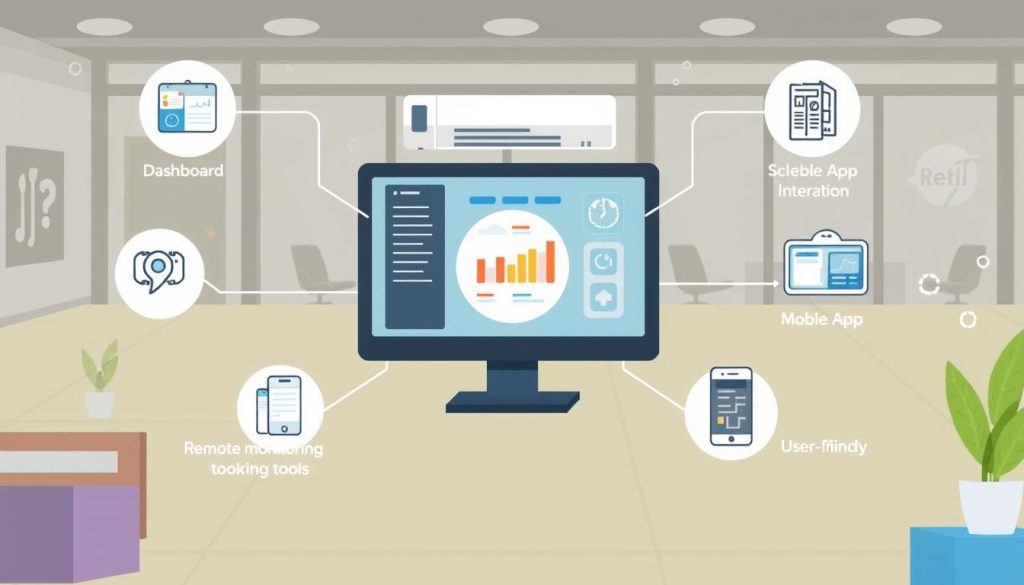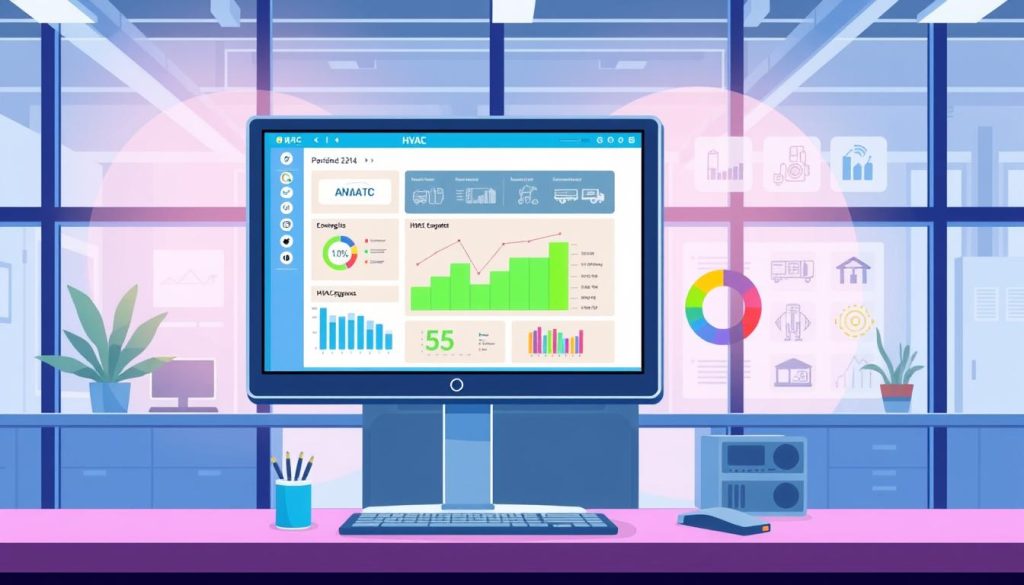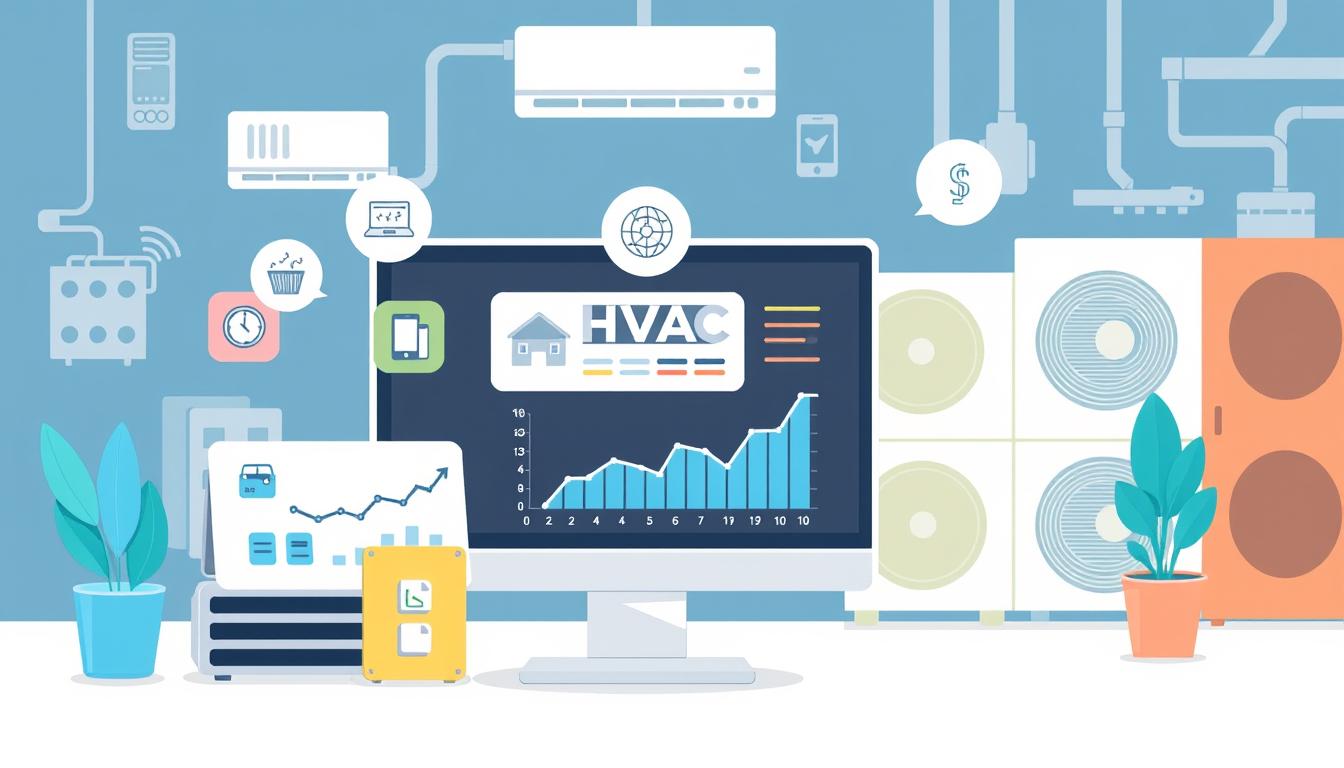HVAC software prices vary a lot. As an HVAC pro, think about your business needs, the features you need, and how much support you want. Small HVAC businesses might pay $20 a month to $500 for basic software. Big companies could spend $299 a month or up to $6,000 upfront.
Many things affect HVAC software costs. These include how many users you have, the software’s complexity, and the support you get. You also need to think about setup fees, ongoing costs, and extra services. All these can change how much you’ll spend on your HVAC software.
Key Takeaways
- HVAC software costs can range from $20 per month to $6,000 in upfront fees, depending on the business size and feature requirements.
- Pricing is influenced by the number of users, complexity of features, level of support, and implementation fees.
- Smaller HVAC businesses typically pay $20-$500 per month, while larger enterprises may invest $299 per month or more.
- Evaluating the specific needs of your HVAC business is crucial to selecting the right software solution at the appropriate cost.
- Considering the long-term benefits and return on investment (ROI) can help justify the HVAC software expenditure.
HVAC Software Pricing Overview
HVAC software pricing can change a lot based on several important factors. Knowing these can help you plan your budget and choose the right software for your business.
Factors Affecting HVAC Software Costs
The cost of HVAC software depends on a few main things:
- Software features and capabilities – Software with more features like scheduling and invoicing costs more than simple software.
- Number of users and devices – The price often goes up with more users and devices needing access.
- Level of support and training – Getting more help and training can mean higher costs.
- Cloud-based vs. on-premise deployment – Cloud software costs less upfront but more over time. On-premise software costs more at first but less later.
- Business size and scale – Larger companies pay more for software than smaller ones.
Average Pricing for HVAC Software
Research shows the average cost for HVAC software is:
| Software Type | Pricing Range |
|---|---|
| Basic HVAC Software | $50 – $150 per user per month |
| Mid-range HVAC Software | $100 – $300 per user per month |
| Enterprise HVAC Software | $300 – $500+ per user per month |
Prices can change based on the factors mentioned. It’s key to look at your business needs and compare prices to find the best option.
Popular HVAC Software Providers and Pricing
Two top names in HVAC software are FieldEdge and Housecall Pro. They cater to different needs with various features and prices.
FieldEdge HVAC Software
FieldEdge makes HVAC work easier and better for customers. It helps technicians manage their time well and get to jobs on time. It also makes it easy to send invoices and get paid quickly.
FieldEdge starts at $99 a month for the basic plan. There are more features and custom options for higher prices. It suits small, medium, and big HVAC businesses.
Housecall Pro HVAC Software
Housecall Pro is known for being easy to use and packed with features. It’s great for online bookings, sending out jobs, and digital invoices. It helps HVAC pros give top-notch service.
Housecall Pro’s prices start at $99 a month for the basic plan. There are more features and support options at higher prices. It’s flexible for businesses of all sizes.
| HVAC Software Provider | Pricing Range | Key Features |
|---|---|---|
| FieldEdge | $99 – $299+ per month |
|
| Housecall Pro | $99 – $249+ per month |
|
FieldEdge and Housecall Pro offer top-notch HVAC software. They have unique features and prices. HVAC businesses should look at what they need and compare these providers to choose the best one.
How much does HVAC software cost?
When looking at HVAC software costs, several factors come into play. The price can change based on the software’s features, what you need, and your business size. Knowing the average cost helps you plan your budget and choose the best software for you.
Average HVAC Software Pricing
HVAC software prices usually fall between $50 to $300 per user monthly. But, the actual cost can be affected by a few things:
- Number of users – More users mean higher costs.
- Features and functionality – Features like scheduling and invoicing can raise the price.
- Customization needs – Making the software fit your business can cost extra.
- Integration with other systems – Connecting the software with your tools can also affect the price.
- Support and maintenance – The cost of ongoing support and updates should be considered.
Comparing HVAC Software Costs
| HVAC Software Provider | Pricing Range | Key Features |
|---|---|---|
| FieldEdge | $99 – $199 per user/month | Scheduling, dispatching, invoicing, customer management |
| Housecall Pro | $49 – $149 per user/month | Scheduling, payment processing, reporting, CRM |
When comparing costs, think about what each software offers. The right HVAC software can make your business run smoother, improve customer service, and increase profits.
Key Features Driving HVAC Software Pricing
HVAC software pricing can vary based on its features. Key factors include scheduling, dispatching, invoicing, and payment processing. These features can make the software more expensive.
Scheduling and Dispatching
HVAC software scheduling and dispatching help manage technicians’ work. They ensure services are delivered on time. Key features include:
- Real-time availability tracking
- Automated scheduling and dispatching
- GPS-based routing and navigation
- Drag-and-drop scheduling interface
- Calendar synchronization
The more advanced these tools are, the pricier the software.
Invoicing and Payments
HVAC software invoicing and payment processing add to the cost. They include:
- Automated invoice generation
- Customizable invoice templates
- Integrated payment gateways
- Online payment processing
- Recurring billing and subscription management
More advanced invoicing and payment features increase the software’s price. This is because they require more development and upkeep.

Benefits of HVAC Software Solutions
Investing in HVAC software can greatly benefit your business. It streamlines operations and improves customer service. This leads to better efficiency and more profits.
Streamlining Operations
HVAC software benefits include better scheduling and dispatching. This helps manage technician work and cuts downtime. Automated invoicing and payments also save time, letting your team focus on excellent service.
Improving Customer Service
With HVAC software operations, you can give customers updates in real-time. It makes communication smoother and offers easy online booking and payments. These HVAC software customer service features boost customer satisfaction and loyalty.
Choosing the right HVAC software unlocks many benefits for your business. It improves operations and customer service. Look into the options and see how they fit your business needs.
Cost Comparison: HVAC Software vs Traditional Methods
Choosing between HVAC software and traditional methods affects your business’s finances. Let’s look at the costs of each option to help you decide.
HVAC Software Cost Savings
Though HVAC software costs more upfront, it saves money in the long run. It automates tasks like scheduling and invoicing. This makes your team work better and cuts down on expenses.
- Streamlined operations: HVAC software optimizes schedules and routes, saving on fuel and boosting productivity.
- Automated invoicing and payments: It handles billing and payments, cutting down on manual work and errors.
- Improved inventory management: It tracks parts and equipment, ensuring you have what you need and avoiding emergency orders.
Traditional HVAC Methods Drawbacks
Traditional methods, like paper-based scheduling, are slow and error-prone. These issues can lead to higher costs and lost revenue over time.
- Increased labor costs: Manual processes take more time and effort, raising labor costs and reducing productivity.
- Inaccurate data: Paper records are more likely to have mistakes, causing billing errors and inventory problems.
- Lack of visibility: Without a central system, tracking performance and making informed decisions is hard.
| Feature | HVAC Software | Traditional Methods |
|---|---|---|
| Scheduling and Dispatching | Automated, optimized schedules and routes | Manual, time-consuming scheduling |
| Invoicing and Payments | Automated billing and payment processing | Manual data entry and potential for errors |
| Inventory Management | Real-time tracking and optimization | Paper-based or Excel-based inventory tracking |
| Reporting and Analytics | Comprehensive data insights for informed decisions | Limited visibility and difficulty analyzing performance |
The choice between HVAC software and traditional methods depends on weighing upfront costs against long-term savings. By considering what’s best for your business, you can make a choice that boosts growth and profit.
Choosing the Right HVAC Software for Your Business Size
Choosing the right HVAC software is key for your business. The size of your operation matters a lot. Let’s look at what small HVAC businesses and large enterprises need to find the best software.
Small HVAC Business Software Needs
Small HVAC businesses focus on making things easier, better customer service, and keeping costs down. HVAC software for small businesses should have:
- Easy scheduling and dispatching tools to manage techs and customers well
- Simple invoicing and payment options for quick billing and collections
- Mobile access for techs to check job details, update records, and talk to the office
- Good customer management tools to build strong relationships and offer great service
Enterprise HVAC Software Requirements
Bigger HVAC businesses need more from their software. HVAC software for enterprises should have:
- Deep reporting and analytics for tracking important business metrics
- Good inventory and equipment tracking to keep supplies right and track assets
- Integrated accounting and financial tools to simplify business operations
- Tools to manage a big team of techs and support staff
Knowing what HVAC software features for business size you need helps you pick the right software. This ensures your HVAC software meets your business’s specific needs. It boosts efficiency, productivity, and profits.
Evaluating HVAC Software ROI
When thinking about HVAC software, it’s key to look at the return on investment (ROI). The right software can save a lot of money and make operations more efficient. But, it’s important to know what affects the ROI to make a smart choice.
What are the primary benefits of HVAC software that can drive ROI?
HVAC software offers many benefits that can lead to a good ROI. These include:
- Improved productivity and efficiency through better scheduling and job management
- Enhanced customer service with real-time updates and faster invoicing
- Reduced operational costs by managing fleet and inventory better
- Increased revenue from upselling and accurate job costing
How do I calculate the ROI of HVAC software?
To figure out the ROI of HVAC software, start with the initial costs and ongoing fees. Then, think about the savings and revenue boosts it can bring. This includes:
- Less money spent on administrative tasks
- More efficient technicians
- More money from upselling and better job costing
- Less money on vehicle upkeep and fuel
- Keeping more customers and getting more referrals
By comparing the total cost of the software to the expected savings and revenue, you can see if it’s worth it.
What are the key factors that affect HVAC software ROI?
The ROI of HVAC software depends on several things. These include:
- Business size and complexity – Bigger HVAC companies might see more ROI
- Existing operational inefficiencies – Companies with old, slow processes will likely see big benefits
- Software features and functionality – The software’s abilities can greatly affect savings and revenue
- User adoption and training – Getting everyone to use the software well is key to ROI
Knowing these factors helps HVAC businesses decide if the software is right for them. It also helps plan for a successful use to get the best ROI.

| HVAC Software Cost Savings | HVAC Software Revenue Increases |
|---|---|
| Reduced administrative labor costs | Increased revenue from upselling |
| Improved technician productivity | Better job costing and pricing |
| Optimized fleet management | Improved customer retention and referrals |
| Streamlined inventory management | Faster invoicing and payment collection |
Implementing and Training for HVAC Software
Getting HVAC software up and running is key to success. It’s a big step, but it can be rewarding. It sets your HVAC company up for success in the long run.
What Is Involved in HVAC Software Implementation?
Implementing HVAC software means several steps:
- First, look at your current business processes. See where the software can help.
- Then, pick the right HVAC software for your needs.
- Next, integrate it with your systems and data.
- Configure it to fit your workflows and preferences.
- Finally, move your data from old systems to the new HVAC software.
How Do You Train Employees on HVAC Software?
Good HVAC software training is crucial. It helps your team use the software well. Consider these points:
- Comprehensive training programs that cover everything.
- Hands-on, interactive sessions to practice what they’ve learned.
- Ongoing support and resources for any challenges.
- Regular refresher courses to keep skills sharp.
What HVAC Software Support Options Are Available?
HVAC software providers offer many HVAC software support services. These include:
- Dedicated account managers for personal help.
- Technical support teams for technical issues.
- Online knowledge bases and tutorials for self-help.
- Regular software updates with new features.
Knowing what’s needed for HVAC software implementation, training, and support is key. It ensures a smooth transition for your HVAC business. With the right steps, you can use these tools to improve operations, customer service, and grow your business.
Conclusion
The cost of HVAC software can change a lot. It depends on how many users you need, what features you want, and how much support you need. Even though it might cost a lot at first, HVAC software can really help your business grow.
Looking at your HVAC business’s needs is key. The right software can make a big difference. It helps with scheduling, invoicing, and more. This means you can work better and serve your customers even better.
Thinking about HVAC software as an investment is smart. It can save you money in the long run. With the right software, you can work more efficiently and grow your business. This is great for your bottom line and for keeping your business strong.





0 Comments